Choosing rain garden plants isn’t as straightforward as it is for traditional flower beds. So in this post, I will give you tons of tips for how to pick the best plants to put in a rain garden, and give you a list of ideas to help get you started.
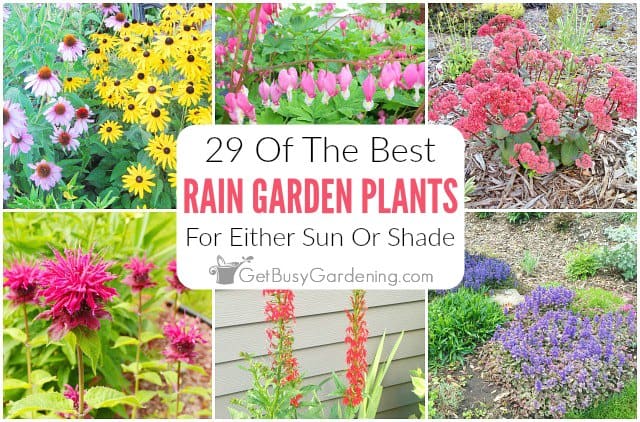
If you’re adding a rain garden to your landscaping this year, then you may be feeling a bit overwhelmed trying to figure out the best pants to use. I completely understand, because I’ve been there, and it can be so difficult!
The reason picking rain garden plants is so complex is because there are three very different sections to fill.
These areas are the top of the berm, the basin, and the inside slope, and each one offers its own unique growing conditions.
Below, I’ll list some of my top choices for the best rain garden plants. This list is definitely not exhaustive, not even close. There are tons of other options that will work great.
So first, I’ll talk about the rules for choosing good plants for a rain garden. Once you understand exactly what to look for, it’ll be easy to find even more wonderful options.
How To Choose Rain Garden Plants
The two most important things to look for when choosing rain garden plants are hardiness, and how much moisture they prefer.
But, just like any other garden area, sunlight, plant height, color, and bloom time are also important things to think about.
Below are the basic rules to follow when choosing the perfect plants for a rain garden.
Related Post: How To Design A Rain Garden Layout
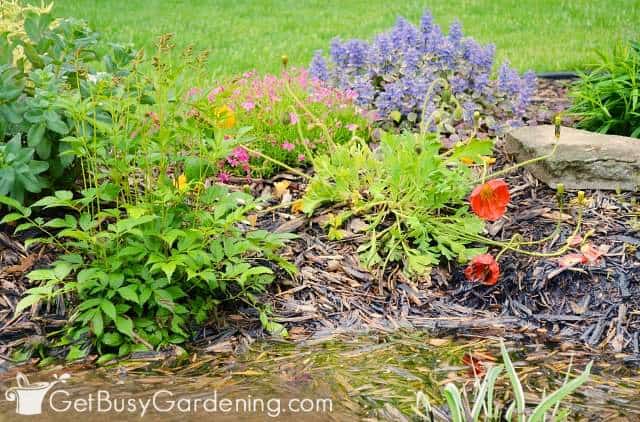
Hardiness
The first thing to understand is that you should always use perennials that are hardy in your growing zone, because annuals and vegetables are not good rain garden plants.
So always consider the hardiness of each plant to make sure that it will thrive in your region.
Moisture
The moisture level in a rain garden ranges from wet to dry, and everything in between. So, it’s important to understand the moisture requirements of the different areas before choosing your plants.
That’s why I have broken my list of rain garden plants below down into the different areas, to make it easier for you to choose.
Sunlight
This is no different than any other garden. But, of course, it’s one of the most important things to consider when choosing rain garden plants.
Before you go shopping, figure out the sun exposure of your garden. Don’t worry if it’s in full sun, partial shade, or full shade, below you will find options for any situation.
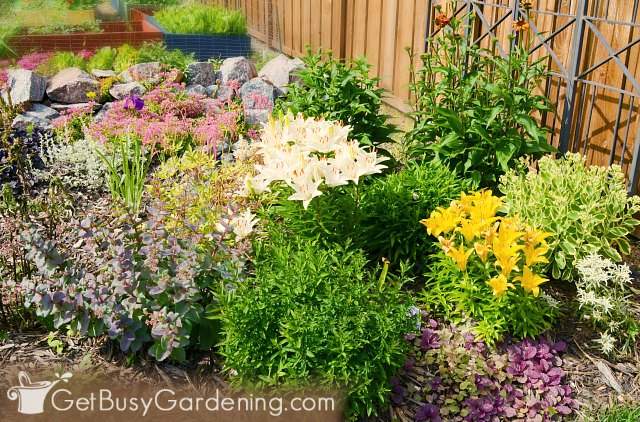
Height
You should also consider their height so that you can plant in layers. That way you can put the tallest ones in the middle, and layer them down so that the shortest are in the front, or around the edges.
Getting the layered effect is easier with rain garden plants. But just remember that the center of the garden (basin) is lower than the top (the berm), so keep that in mind when looking at the different heights.
Bloom Time & Color
Bloom time and flower color, as well as the foliage texture, color, and patterns, are other things to consider.
For the prettiest display, choose a nice selection of rain garden plants that bloom at different times throughout the year.
Then mix in a good variety of flower and leaf colors and textures, which will help to create even more interest.
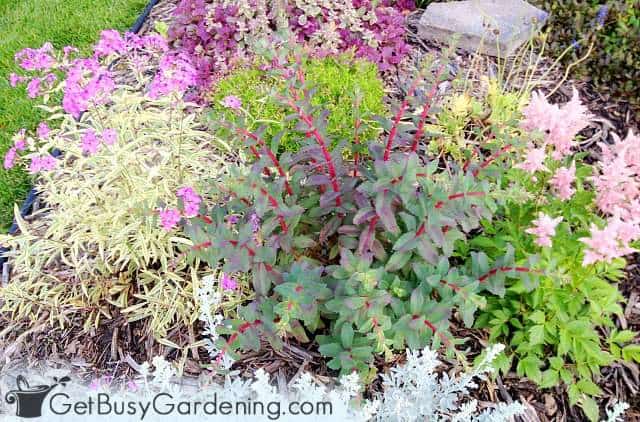
Consider Native Plants
Native plants are a wonderful choice for a rain garden, especially if you want it to be low-maintenance. You already know that they will thrive in your garden, because they are well adapted to the conditions in your growing zone.
They also do well in different types of soil, and tend to be hardier than non-natives. Native plants require less maintenance, because they have already adapted to surviving without any help from us.
Plus, they have deep roots, which helps to loosen the soil, so the water will be absorbed faster. They’re also great for supporting native pollinators and wildlife.
However, be sure to do your research. Native plants can sometimes look weedy, or be more aggressive than many home gardeners would like.
29 Best Rain Garden Plants
As I mentioned above, there are three different planting areas you need to consider when choosing rain garden plants: the basin, the inside slope, and the berm. The plants that will thrive in each of these areas are very different.
Below I broke down my list by the three areas, and also grouped them for sun or shade. So, no matter what the sun exposure, you’ll have a nice selection to choose from.
Related Post: How To Build A Rain Garden Step-By-Step
Plants For The Rain Garden Basin
The basin is the deepest part at the center of a rain garden, and it’s where the water pools after a rainfall. Plants that do best in the basin are ones that like average to moist soil conditions.
They should have deep roots, which will help the water drain faster. These should also be the tallest plants.
Basin plants need to be able to tolerate short periods of standing water and soggy soil. True wetland plants are not a good choice, because the water doesn’t sit in the basin long enough to sustain them.
Sun
- Goldenrod (Solidago speciosa) – Goldenrod enjoys being in full sun to part shade. They have beautiful, bright yellow flowers through the summer, and are native prairie plants. It grows well in zones 3-8, and will get between 24-48” tall.
- Prairie blazingstar (Liatris pycnostachya) – With tall, fluffy spikes of pink or purple flowers, prairie blazingstar blooms in mid to late summer, and thrives in direct sun. They’re between 18-36” tall, hardy in zones 3-9, and the bees love them.
- Water iris (Iris ensata) – The water iris has colorful purple blooms that flower in early to mid summer in zones 4-9. They prefer sun to part shade, have interesting spiky foliage, and are 24-36” high. If you are looking for even more color, choose one with variegated foliage.
- ‘Little Joe’ pye weed (Eupatorium dubium) – Little Joe’ pye weed prefers full sun to part shade, and will have light purple flowers in the late summer. They’re 36-48” tall in zones 4-8, and butterflies can’t resist them.
- Bee balm (Monarda bradburiana) – If you have sun to part shade, and are looking for something to attract bees and butterflies, then bee balm is the right choice. It gets to be 12-24” high, and has tall pink, light purple, to dark pink flowers that bloom in early summer. This perennial herb does best in zones 4-8.
Related Post: 21 Of The Best Plants & Flowers For Attracting Bees

Shade
- Turtlehead (Chelone) – Turtlehead plants do well in zones 3-8 in partial to full shade. They have white, pink, or purple flowers that bloom in late summer to fall, and gorgeous dark green foliage. These plants are 24-36’ tall.
- Maidenhair fern (Adiantum pedatum) – This pretty foliage plant does well in partial to full shade, and likes moist soil. Maidenhair ferns are 12-36” tall and, while they don’t bloom, they make a beautiful backdrop for other flowers in zones 3-8.
- Sedges – Sedges do well in full shade to sun, and their hardiness will vary by species. Their foliage adds interest and texture, and can create the illusion of moving water when the wind blows. They can be between 24-48” tall, depending on the variety.
- Cardinal flower (Lobelia cardinalis) – The cardinal flower has bright red spikes of flowers that hummingbirds and pollinators adore. They bloom in late summer through fall, grow well in sun to shade in zones 2-9, and are 24-36” tall.
- Black snakeroot (Actaea racemosa) – Black snakeroot has gorgeous, dark red to maroon foliage, which is made even more striking by the white flower spikes that bloom in late spring to early summer in zones 4-8. These plants need consistently moist soil and full shade, and are approximately 48” tall.
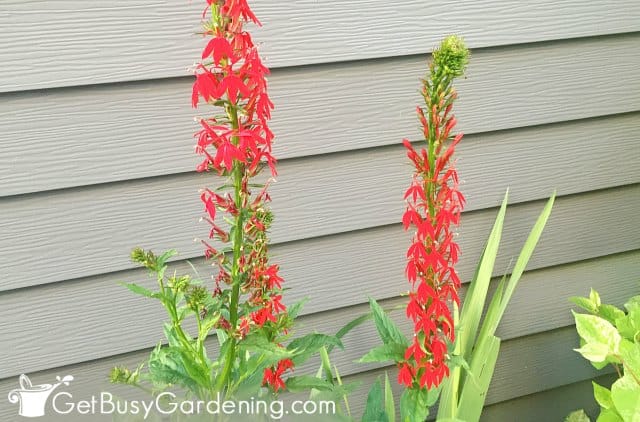
Rain Garden Plants For The Inside Slope
The inside slope is the space between the berm and the basin. When the rain garden basin is full, these plants will be flooded, but they’ll dry out faster than the ones in the middle.
Plants that do best on the inside slope are the ones that like wetter than average moisture conditions, and can tolerate short periods of standing water.
Choose medium-height rain garden plants that are shorter than the ones you’re going to put in the center.
Sun
- Astilbe – These beauties do well in sun to shade, depending on the variety. Also called false goat’s beard, they come in various heights and colors, and do well in zones 4-9. They will bloom in spring to early summer, with tall, wispy flower spikes.
- Purple coneflower (Echinacea purpurea) – Purple coneflowers like part shade to full sun, and bloom in mid-summer. Other varieties have white, red, and orange flowers. All are adored by birds and butterflies. They do well in zones 2-10, and are 24 to 48“ tall.
- Coral bells (Heuchera) – These adorable plants come in a variety of colors, and the flowers dangle from 18” tall spikes that bloom in spring through the summer. Coral bells come in a wide variety of stunning foliage colors, do well in zones 4-9, and anywhere from sun to shade, depending on the cultivar.
- Butterfly weed (Asclepias tuberosa) – A host plant for the monarch caterpillar, the bright orange flowers attract other pollinators and bees too. Butterfly weed enjoys direct sunlight to part shade, and is 24-36” tall in zones 4-9.
- Rudbeckia – With lovely red, yellow, or maroon flowers that bloom in late summer, depending on the cultivar, rudbeckia attracts birds and pollinators. They do well in zones 3-9 from full sun to part shade. Some varieties only reach a foot tall, while others can be several feet in height.
Related Post: 19 Plants & Flowers For Attracting Butterflies
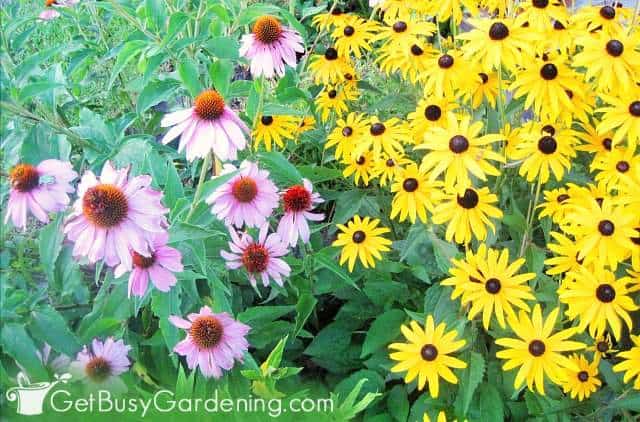
Shade
- Columbine (Aquilegia canadensis) – This cute plant has unique, tubular flowers in late spring to early summer, and they come in tons of different colors. Columbine attracts pollinators, does well in shade to sun in zones 3-8, and is 12-36” tall.
- Asters – Asters prefer sun to shade, dry to moist soil, and bloom at various times. They come in a variety of different colors and heights, depending on the variety, and prefer zones 3-9.
- Prairie coreopsis (Coreopsis palmata) – Prairie coreopsis blooms in early to mid-summer, with vibrant yellow flowers that attract butterflies. They’re 18-36” tall, can take part shade to full sun, and thrive in zones 3-8.
- Bleeding heart (Dicentra spectabilis) – This delicate plant blooms in spring, with heart-shaped pink and white flowers. It dies back in the late summer, so intersperse them to avoid large empty spaces. Bleeding hearts are 18-36” tall, and do best in zones 3-9.
- Lungwort (Pulmonaria) – Lungwort has pink, white, or bluish flower spikes that bloom in mid-spring, with cool spotted foliage. This plant is for zones 4-9 in partial to full shade, and is 12-18” tall.
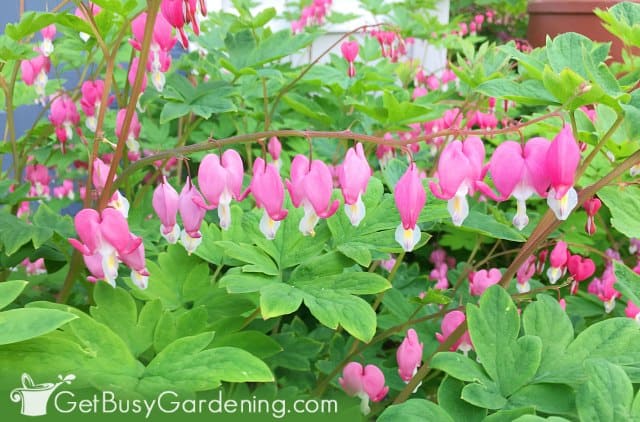
Plants For Rain Garden Berm
The berm is the highest area, or the top of the rain garden. Plants that like average to dry soil conditions go on top of the berm, and around the outer edges.
These plants won’t get wet when the water pools in the center, and will remain dryer than the rest.
Berm plants need to be able to withstand short periods of drought, or prefer dry conditions. These should also be the shortest of your rain garden plants, or even groundcovers.
Sun Plants
- Creeping phlox (Phlox stolonifera) – Creeping phlox is a beautiful groundcover with evergreen foliage, and pink, purple, white, or striped flowers that bloom in late spring to early summer. They enjoy full sun, are 12-18” tall, and hardy in zones 4-8.
- Lilium – Lilium comes in many different colors, heights, and varieties that bloom in the summer. For direct sun areas, choose oriental or daylilies, and remember their hardiness and height can vary by variety.
- Sedums – Sedum or stonecrop of any variety is perfect for the drier areas of the outer edge. They come in many different foliage and flower colors, which bloom summer through fall, and reach 6-24” tall. Great for full sun to partial shade. Check each variety for the hardiness in your zone.
- Russian sage (Perovskia atriplicifolia) – Russian sage has soft silver/gray foliage with delicate purple flower spikes that the bees love. They bloom from late summer through fall, and will tolerate partial shade in zones 4-9. You can expect them to be 24-36” tall.
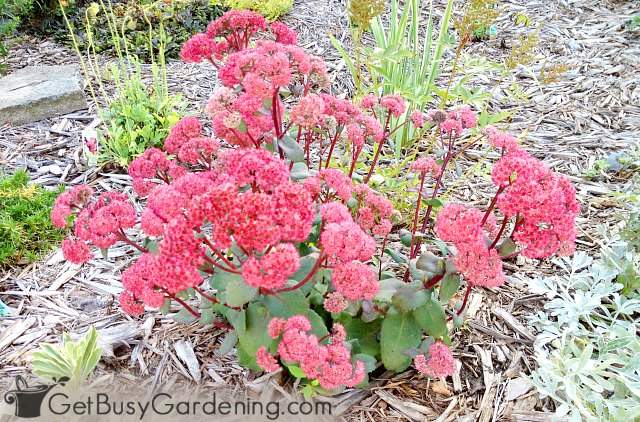
Shade Plants
- Hostas – There are hundreds of different cultivars of hostas, with a wide variety of foliage colors. Their white, pink, or purple tubular flowers form on slender stems, and bloom in mid-summer. They are a favorite of bees, and their hardiness depends on the species chosen.
- Prairie smoke (Geum Triflorum) – Prairie smoke is a native plant that enjoys partial shade to full sun. They bloom in late spring, are 12-18” tall, and hardy in zones 1-8. They provide excellent ground cover, and are perfect for the drier edges of rain gardens.
- Sharp-lobed hepatica (Hepatica acutiloba) – Sharp-lobed hepatica prefers full to partial shade, and blooms in spring in various colors from white to pink, to shades of blue and violet. They remain evergreen through winter, and are 3-6” tall.
- Ajuga (bugleweed) – Ajuga, or bugleweed, likes full shade to sun, and provides wonderful ground cover in zones 4-9. The foliage comes in a variety of gorgeous colors, and the pink or purple flower spikes bloom in early summer.
- Wild geranium (Geranium maculatum) – Wild geranium blooms with bright purple flowers in the late spring to mid-summer in zones 3-8. The foliage will often turn reddish in the fall. They reach 12-18” tall, and prefer sun to partial shade.
Related Post: 17 Best Ground Cover Plants That Grow Well In The Shade
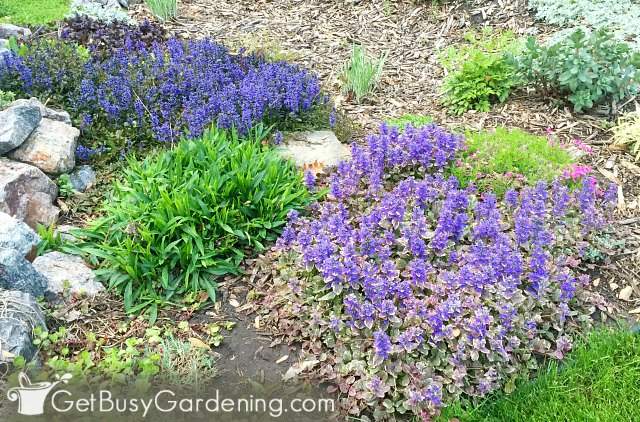
There are so many wonderful plants to use in a rain garden. It doesn’t matter if yours is in the sun, shade, or anywhere in between. And now that you know the rules to follow when shopping for rain garden plants, you’ll have no problem picking the best ones.
Recommended Books
- Rain Gardens: Sustainable Landscaping for a Beautiful Yard and a Healthy World
- The Rain Garden Planner
- The Blue Thumb Guide to Raingardens
- Rain Gardens For the Pacific Northwest
- Rain Gardening in the South
More Posts About Flower Gardening
- Salt Resistant Plants – Top 15 Perennials That Tolerate Salty Soil
- 19 Long Blooming Perennials For A More Beautiful Flower Garden
- When & How To Plant Spring Bulbs
- 17 Pink Flowers For Your Garden (Annuals & Perennials)
Which of your favorite rain garden plants would you add to the list above?

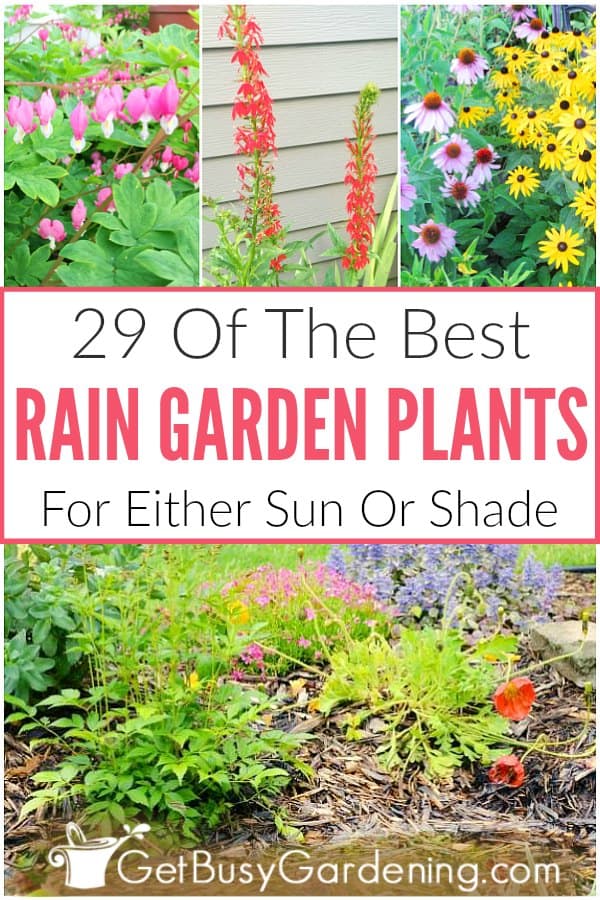
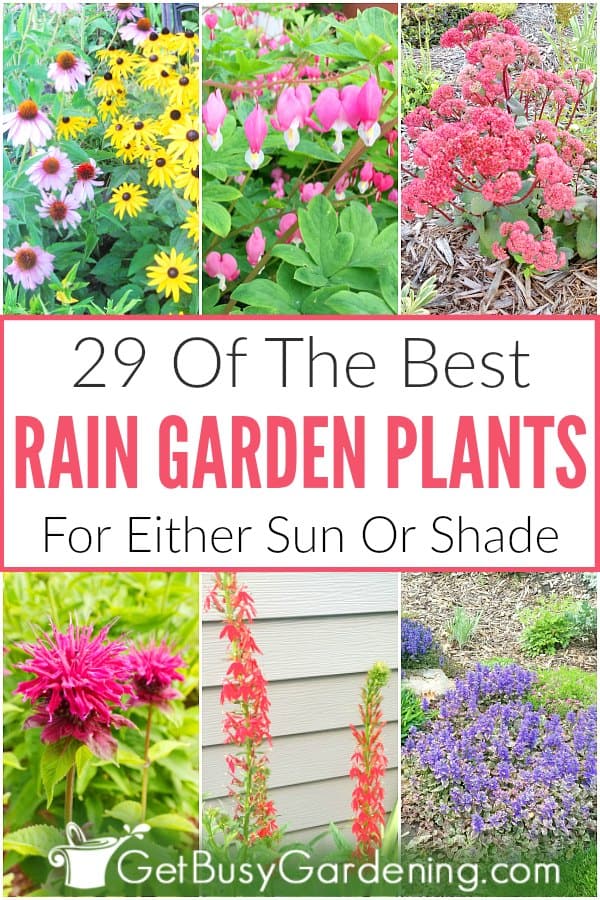


Jen says
Great list Amy! I am also hoping to expand our very small rain garden we started this spring. I am curious about buying plants vs. starting plants by seed. I have read it can take a long time to establish native plants by seed. Have you tried this?
I helped install a community rain garden and designer used White Turtlehead and (I believe) Joe Pie Weed in the basin.
Amy Andrychowicz says
Thank you! Yes, I have started several types of perennial plants from seed. It definitely takes a few more years to get decent sized plants, and for them to flower. But it’s much cheaper than buying mature plants. Native perennials would be a perfect candidate! Rain gardens are becoming very popular, I love to to hear you were involved with a community project like that!
Anonymous says
I would have liked to see some pics during a heavy rain like before you had it built. Please add these.
Amy Andrychowicz says
Sure thing! Take a look at the pictures in this post… Rain Garden Guide For Beginners. There you can see pictures of our mini-rivers and our swampy backyard during a heavy rainfall before we had the rain garden.
GT says
you did great job choosing some gorgeous rain garden plants. very nice.
Amy Andrychowicz says
Thank you!
PlantPostings says
Very nice, Amy! It would be fun to see your rain garden with all the plants filled in.
Amy Andrychowicz says
Thank you! You can see pictures of my rain garden plants all filled in here… Rain Gardens: A Detailed Guide For Beginners.
RandomGardener says
That list looks great! I especially love the purple coneflowers and black eyed susan plant combo. It's beautiful!
Amy Andrychowicz says
Thanks! Yes, that is one of my favorite plant combinations too. Perfect for a rain garden, or really and flower bed!
From Sugar Cookies to Peterbilts says
The list looks great! Would love to pictures of your rain garden once all the plants grow!
Amy Andrychowicz says
Thanks! You can find some great photos of everything filled in here… Rain Gardens: A Detailed Guide For Beginners. I wasn’t able to use all of the plants on this list, but have several of them growing in there.
El Gaucho says
This plant list looks great. Well done!
Amy Andrychowicz says
Thanks! Hopefully I’ve inspired you to add a rain garden sometime too. 🙂